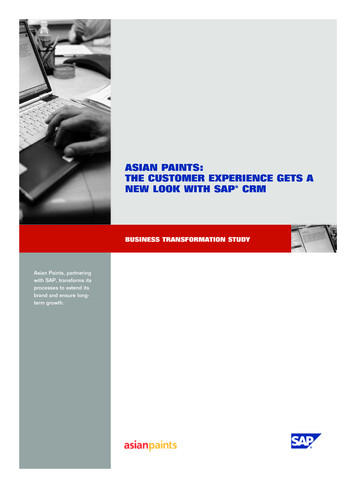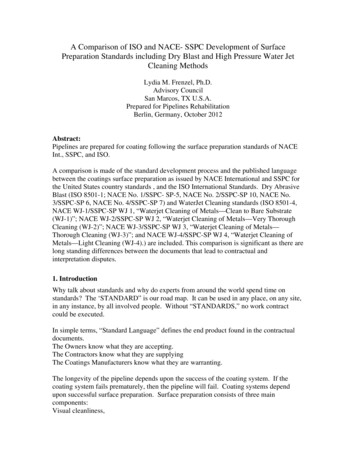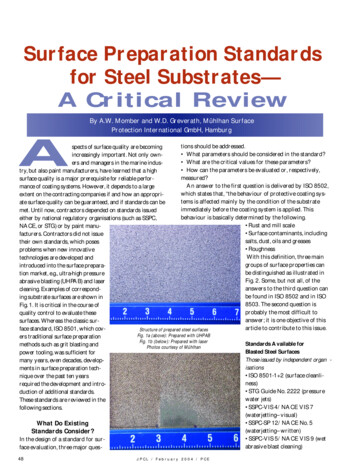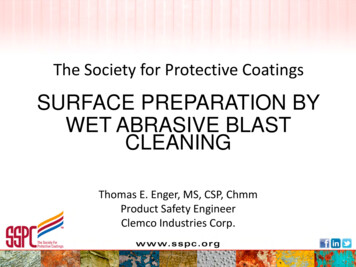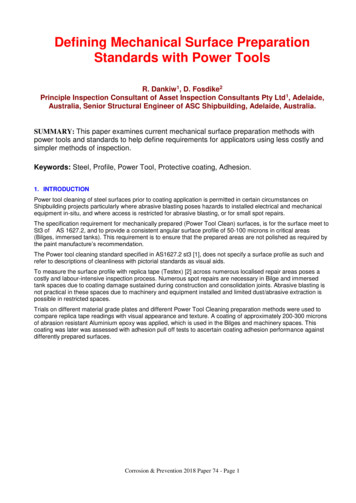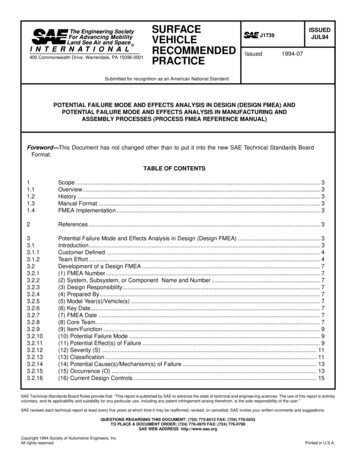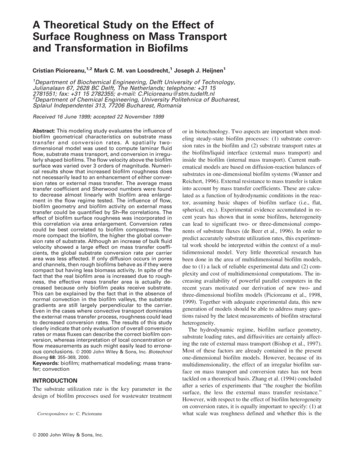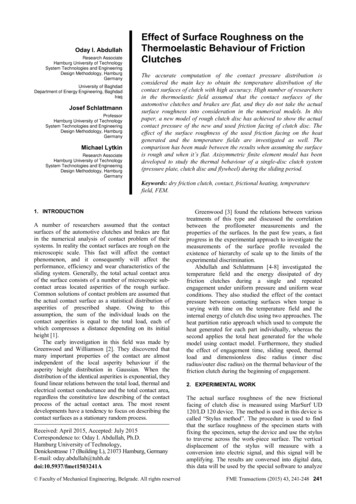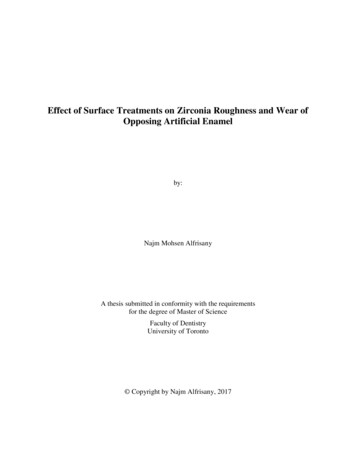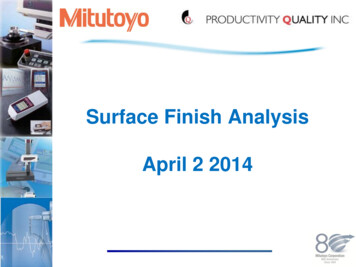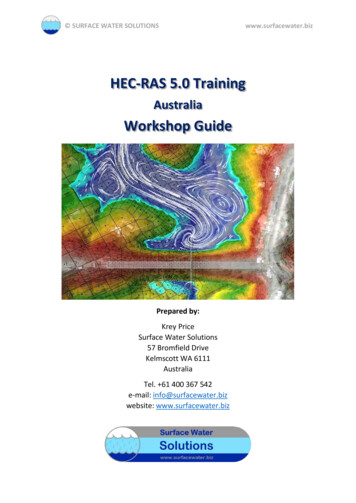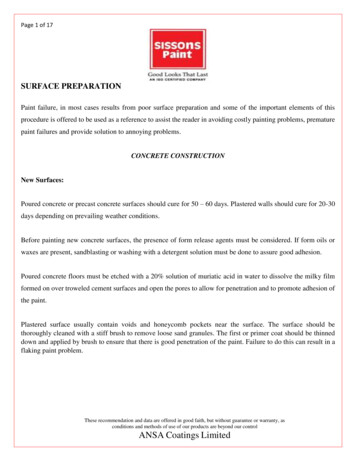
Transcription
Page 1 of 17SURFACE PREPARATIONPaint failure, in most cases results from poor surface preparation and some of the important elements of thisprocedure is offered to be used as a reference to assist the reader in avoiding costly painting problems, prematurepaint failures and provide solution to annoying problems.CONCRETE CONSTRUCTIONNew Surfaces:Poured concrete or precast concrete surfaces should cure for 50 – 60 days. Plastered walls should cure for 20-30days depending on prevailing weather conditions.Before painting new concrete surfaces, the presence of form release agents must be considered. If form oils orwaxes are present, sandblasting or washing with a detergent solution must be done to assure good adhesion.Poured concrete floors must be etched with a 20% solution of muriatic acid in water to dissolve the milky filmformed on over troweled cement surfaces and open the pores to allow for penetration and to promote adhesion ofthe paint.Plastered surface usually contain voids and honeycomb pockets near the surface. The surface should bethoroughly cleaned with a stiff brush to remove loose sand granules. The first or primer coat should be thinneddown and applied by brush to ensure that there is good penetration of the paint. Failure to do this can result in aflaking paint problem.These recommendation and data are offered in good faith, but without guarantee or warranty, asconditions and methods of use of our products are beyond our controlANSA Coatings Limited
Page 2 of 17Old or Previously Painted Surfaces:The most common exterior paint failures in the tropics on masonry surfaces are cracking and flaking anddiscoloration from fungus/mildew.Cracking & Flaking:This is mainly caused from painting over heavy chalk deposits that have not been properly removed. Chalkdeposits are formed on old exposed painted surfaces when the coating system has started to disintegrate.The most efficient way to remove this loose, friable substance is with high-pressure spray equipment. Multiplecoats of paint must be completely removed, thereby exposing a sound substrate before attempting to repaint. It isrecommended that the prepared surface be sealed with Sissons Penetrating Liquid or Sissons Weather Guard,thinned 2:1 with clean water as a first coat.Mildew/Fungus Infested areas:This is a major cause of paint discoloration and disfigurement of exterior building in the tropics. Surfaces mustbe sterilized before painting. External concrete or plastered surfaces left untreated for several months may becomeinfected with fungal spores and may require washing with a Sissons biocidal solution before painting. Old paintwork which shows signs of disintegration must be pressure washed to a sound substrate. Paint in good conditionbut discolored by fungus must be soaked with the biocidal solution and scrubbed. If complete removal is notachieved, then the procedure must be repeated.These recommendation and data are offered in good faith, but without guarantee or warranty, asconditions and methods of use of our products are beyond our controlANSA Coatings Limited
Page 3 of 17EFFLORESCENCEThis is a white crystalline deposit on the face of a wall and also often seen on newly laid bricks/tiles. It is causedby the presence of moisture bringing soluble salts to the surface and eventually drying, leaving a white deposit.Removal is done by wiping or washing off with a 10% muriatic and acid solution, followed by flushing with cleanwater, to remove the acid. If the problem is persistent then a major build-up of salts may occur, pushing the paintfilm to form unsightly craters/blisters. The solution to this is to locate and correct the source of the moistureconditions causing the problem. In some cases, especially on old buildings where damp-proofing was never done,the problem may only be solved by major re-construction work.WOODEN SURFACESNew Wood:Sand to a smooth finish and dust off. Apply two (2) coats of Sissons Sanding Sealer over knots or heavy resinousarea. e.g. the very dark oily areas on some pieces of pitch pine. Finish using one coat Sissons Universal Undercoatand two (2) coats of paint, allowing adequate drying time between coats and sanding lightly after each coat. Anideal paint for interior or exterior work is the SISSONS Super Gloss Paint in which case a primer is not requiredas the paint has a built-in primer.Old Painted Wooden Surfaces:Old paint showing blistering or flaking should be cleaned by scraping and sanding to a sound substrate. Exposedwood should be spot primed using SISSONS Super Gloss paint before finishing with one or two coats of SuperGloss Paint.These recommendation and data are offered in good faith, but without guarantee or warranty, asconditions and methods of use of our products are beyond our controlANSA Coatings Limited
Page 4 of 17Paint in good condition i.e. not cracking or peeling but showing chalkiness must be washed thoroughly, fungusinfested areas must be sterilized, and glossy areas must be sanded to ‘break’ the gloss and hence promote goodadhesion.Unexposed areas such as eaves, ceiling etc. apply Sissons Biocidal Solution. Varnished surfaces if not cleanedoccasionally may ‘go black’ and may cause the wood itself to darken resulting in an unattractive surface.PREPARING METAL SURFACESProper surface preparation considerably enhances a coating’s performance, so it is essential that the surface beprepared in the best possible manner. The type of preparation chosen would depend on cost, accessibility,contamination of manufacturingprocess, etc.These recommendation and data are offered in good faith, but without guarantee or warranty, asconditions and methods of use of our products are beyond our controlANSA Coatings Limited
Page 5 of 17The following procedures are summaries of the Steel Structures Painting Council (SSPC). The Swedish Standardis also given where applicable.SOLVENT CLEANING: Solvents, emulsions, cleaning compounds, steam cleaning or similar materials andmethods are used to remove oil, grease, dirt, drawing compounds and other similarforeign matter from surfaces prior to painting. Certain corrosive salts, such as chloridesand sulfates must be removed with water before cleaning the surface with hydro-carbontype solvents.SSPC - SPI - 63When rags or waste are used with solvents for cleaning they should be replaced frequentlywith clean ones, as they absorb grease and then act as a transportation agent for the greaseor other contaminants. Use plenty of clean rags, and as an added safety measure, rinse thesurface with clean saturated rags. Gasoline and Benzene should never be use.Solvent cleaning should be undertaken only with adequate ventilation. Caution shouldalways be observed for danger or solvent inhalation or fire.HAND TOOLCLEANING:SSPC - SP2-63Swedish Standard St. 2This method is generally confined to the use of scrapers, sandpaper, wire-brushing orhand impact tools to remove loose mill scale, non-adherent rust, and scaling paint or otherforeign matter. Hand tool cleaning is normally used in areas not subject to corrosiveenvironment or on surfaces not intended for top coating with poor wetting systems suchas those based on Vinyl Chloride. Special attention should be given to weld seams orspots. Always remove weld flux and spatter as it may initiate localized paint failure whichcan expand to cover larger areas.POWER TOOLCLEANING:SSPC-SP-3-63Swedish Standard St. 3This method employs the use of power wire brushes, impact tools, grinders and powersanders to remove loose mill scale, loose rust, paint or other foreign matter. Power toolcleaning should be employed by experienced personnel. Burnished mill scale cansometimes be mistaken for bright metal. Primers applied to burnished metals will notadhere properly.FLAME CLEANING OFNEW STEEL:SSPC - SP – 4 - 63One traverse of the flame cleaning head, followed by wire brushing, is normally sufficientto remove new or old steel that has been partially weathered. Badly rusted or heavilyscaled steel should be treated as previously painted or “old work”. At best, flame cleaningwill give results somewhere between that obtained by power tool and commercial blastcleaning. The individual job determines the type of gas and speed of traverse required foracceptable cleaningThese recommendation and data are offered in good faith, but without guarantee or warranty, asconditions and methods of use of our products are beyond our controlANSA Coatings Limited
Page 6 of 17BRUSH-OFF BLASTCLEANING:SSPC – SP – 7 – 63 SA1This is a relatively low-cost method of cleaning and is often used at the job site to cleanmaterials that are shop and field coated before installation. This type of cleaning is notgenerally recommended to severe environments. It is often used to remove temporarycoatings applied for the protection of equipment in transit or on storage. It is also used toremove old finishes in bad condition.A brush-off blast clean surface is defined by the SSPC as one from which all oil, grease,dirt, rust-scale, loose mill scale, loose rust and loose paint or coatings are removedcompletely. However, tight mill scale and tightly adhered rust, paint and coatings arepermitted to remain – provided that all mill scale and rust have been exposed to theabrasive blast pattern sufficiently to exposed numerous flocks of the underlying metaluniformly distributed over the entire surface.This method can be effectively used to clean rusty galvanized surfaces and to remove oldfinishes in poor condition.COMMERCIAL BLASTCLEANING:SSPC – SP – 6 - 63This type of blast cleaning is generally considered adequate for most surfaces requiring agood clean surface for painting. The advantage of commercial blast cleaning lies in thelower cost of satisfactory preparation for most service conditions. Blast cleansed surfacesshould be primed as soon as possible.A commercial blast cleaned surface finish is defined as one in which all oil, grease, dirt,rust scale and foreign matter have been completely removed from the surface and all rustmill scale and old paint have been completely removed except for slight shadows, streaks,or discolorations caused by rust stain mill scale, oxides or slight, tight residues of paintor coating that may remain; if the surface is pitted, slight residues or rust or paint, may befound in the bottom of pits, at least two-thirds of each square inch of surface area shallbe free of all visible residues. The remainder shall be limited to the light discoloration,slight staining or light residues mentioned above.PICKLING:SSPC- SP- 8 - 63Pickling is a method of preparing metal surfaces for painting by completely removing allmill scale, rust, and rust scale by chemical reaction, or by electrolysis, or by both. It isintended that the pickled surface shall be completely free of unreacted or harmful acid oralkali, or smut.NEAR WHITEBLAST CLEANING:SSPC- SP- 10 - 63TSwedish StandardSA 2.5A near-white blast cleaned surface is defined as one from which all oil, grease, dirt, millscale, rust, corrosion products, oxides, paint and other foreign matter have beencompletely removed from the surface, except for very light shadows, very slightdiscoloration caused by rust stain, mill scale, oxides or slight, tight residues of paint thatmay remain.At least 95% of each square inch of area shall be free of all visible residue and theremainder limited to the light discoloration mentioned above. Priming of cleaned surfacesmust be done as soon as possible, particularly in humid or corrosive environments.These recommendation and data are offered in good faith, but without guarantee or warranty, asconditions and methods of use of our products are beyond our controlANSA Coatings Limited
Page 7 of 17WHITE METAL BLAST:SSPC- SP- 5- 63Swedish Standard SA3This system of cleaning is mandatory for preparing the interior of tanks prior to theapplication of a lining. The cost is comparatively high, and it is generally used for workonly when such costs are warranted. In some cases, accessibility after erection is notpossible, therefore, under such conditions the use of blasting to white metal beforeerection is considered economical.This system provides the maximum surface preparation and should result in the bestperformance possible from the painting system chosen. Surface preparation of thismagnitude is often done in the field after the equipment or structure is in place.The use of white metal blast cleaning without rust-back in areas of high humiditynecessitates the choice of blasting time so that no rust-back can occur, and whenpainting can be completed at least the same day.A white metal blast cleaned surface finish is defined by the SSPC as a surface with agrey-white, uniform metallic colour, slightly roughened to form a suitable anchorpattern for coatings. When viewed without magnification, the surface should be free ofall oil, grease, dirt, visible mill scale, rust, corrosion products, oxides, paint or any otherforeign matter.GALVANIZED METAL:Standard paint systems such as oil or alkyd-based house paint or rust inhibitive primersshould not be applied directly on new galvanized metal. Applying these coatingsdirectly to new untreated galvanized metal may create a reaction between the zinc andcoating, causing loss of adhesion. New galvanized metal exposed to a mild interior orexterior environment may be successfully coated by first thoroughly cleaning thesurface with rags saturated with mineral spirits, then priming with SISSONS One PackEtch Primer.An etch primer should be recoated within 2 – 4 hours and not allowed to standovernight, to avoid moisture condensing on the primer. For superior protection a metalprimer is recommended followed by conventional solvent or water-based system. Thechoice of product and colour is dependent on the type of exposure.Weathered galvanized surfaces covered with “white rust” must be thoroughly cleanedby wire brushing or sanding. A quick and highly effective method of cleaning is the useof hi
SSPC- SP- 10 - 63T Swedish Standard SA 2.5 A near-white blast cleaned surface is defined as one from which all oil, grease, dirt, mill scale, rust, corrosion products, oxides, paint and other foreign matter have been completely removed from the surface, except for very light shadows, very slight discoloration caused by rust stain, mill scale, oxides or slight, tight residues of paint that may .
